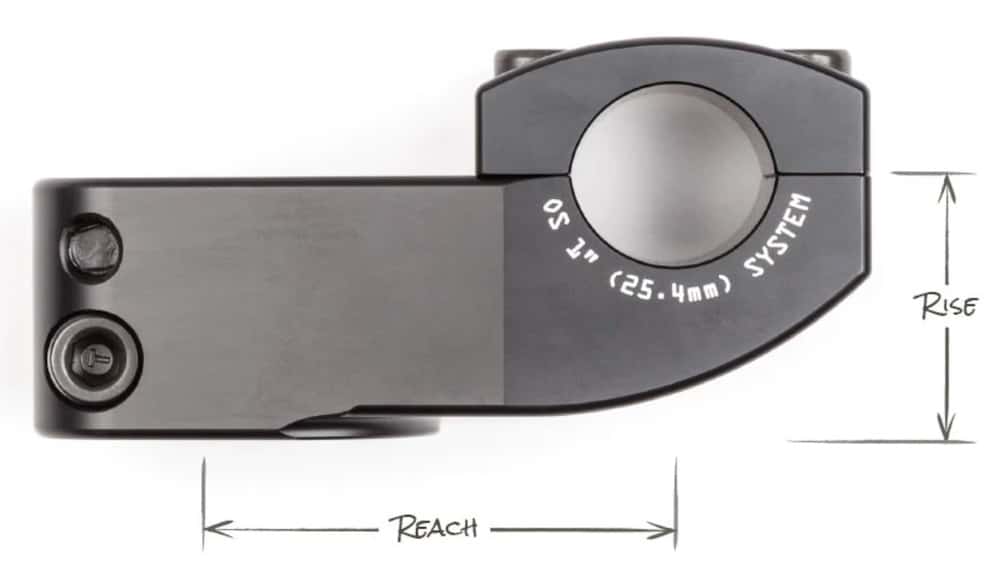If you’ve ever wondered how to pick the right BMX stem size, you have come to the right place.
When I first started riding BMX, I didn’t really care about the stem. In fact, I didn’t bother about any bike specs – I just wanted to ride as much as possible.
I learned that I could actually change the feel of my bike drastically by switching to a different BMX stem years later.
Those were the good times.
But now, times are even better because I know what stem size fits me perfectly.
And I’ll help you choose the right one for yourself, too.
This post covers:
- BMX stem dimensions & measurements
- Bonus: Other BMX stem dimensions
- Conclusion: How to choose the right BMX stem size
BMX Stem Dimensions & Measurements
You will see two words mention when selecting a stem: Reach and rise.
What do they mean?
| Spec | Description |
| Reach | Dimension from the center of the steerer tube to the center of the bar clamp |
| Rise | Dimension from the bottom of the stem to the center of the bar clamp |
| Stack height | Thickness of the base of the stem |
The Reach Of A BMX Stem

As the image above shows, reach (some call it length) is the dimension between the center of the steerer tube and the center of the bar’s clamping hole.
The longer it is, the more stable your bike will feel. And the shorter it is, the twitchier it is.
The most common stem reach is 50mm.
- Short-reach BMX stem: This is the version that’s getting more and more popular in modern street riding. It’ll make your bike feel a lot more responsive. It’s great for spins, front wheel stuff and even barspins (because it puts the bar closer to your body).
- Long-reach BMX stem: This is the best version to build a stable bike for trail and transition riding. If you’re into flow and speed, get a longer stem.
- Zero-reach BMX stem: This is a flatland stem that has a top load design, clamping the bar directly above the center of the steerer tube.
What you can also do with different reaches is compensate a frame’s top tube length (TT) that feels too short or too long.
Instead of getting a new frame, you can get a shorter-reach stem if the TT feels long or a long-reach version for a shorter-feeling frame.
But before getting a new stem, you can also move your bar backward or forward (just slightly) to see what feels best for you. (This can also help if your frame feels fantastic, but you think you got the wrong stem reach.)
The Rise Of A BMX Stem

The second and, in my opinion, even more, important stem measurement is the rise.
It measures from the bottom of the stem to the center of the clamping area.
The higher the rise, the more upward you’ll stand, which makes the bike feel more stable, but at the same time, it doesn’t impact your nose manuals and bunnyhops. In fact, bunnyhops become easier if you raise your front end.
BUT!
If you go too high, (in case you pick the highest top load BMX stem), you may need to get used to it.
You may be looping out a lot if you have a frame with a short chainstay and raise your bar (too much).
(Hey, you may also be interested in reading my guide on the best BMX chainstay length.)
So if you don’t want that extra height, you can also get a BMX front load stem.
However, if you’re unfamiliar with the available BMX stem types, I have you covered!
What to do if you mess things up?
Use spacers! And if you want to go extra high, get a 10″ BMX bar.
The Stack Height Of A BMX Stem
When buying a new stem, you may also notice some brands and online stores mention the stack height. But that happens rarely.
Why? Because it’s not that important.
What is a stack height? It’s the thickness of the base of the stem, where it wraps around the steerer tube.
Remember, the stack height won’t necessarily affect the stem’s rise.
Bonus: Other BMX Stem Dimensions
While the first one isn’t really important, you may need to be more cautious with the latter.
BMX Stem Bolts Size
Stem bolts have the standard M8 (8 X 1.25mm) thread and fit the 6mm Allen key.
What can be different is the bolt head size (some have larger and some smaller diameters).
BMX Stem Clamp Size
I’m bringing this one up because my dude, Joel, accidentally bought a stem with the wrong clamping diameter.
While the standard stem clamp size is 7/8″ (22.2mm), more and more BMX brands are moving to the oversized (OS) version, which has a 1″ (25.4mm) clamping area.
Because of the extra surface, a 1-inch BMX stem grips the bar firmer, reducing the chance of slipping.
Conclusion: How To Choose The Right BMX Stem Size
It all comes down to the riding style you like.
If you’re into technical street riding and flatland, a short-reach stem would be ideal.
And if you like to go fast and need the extra stability, then picking a long-reach stem is what I recommend.
As far as the rise goes, if you like the bar closer to your body and not be all hunched over when you pedal, then opt for a high-rise stem. I’d say it is a must for all taller riders.
However, even if you get a low-rise stem (or you like a front load stem more), you can still compensate the height of your front end with spacers and a bigger BMX bar.






